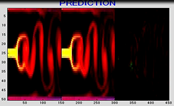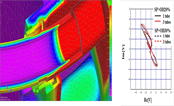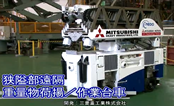Classification
1 - A(Inspection)
Seawater piping employed for cooling of emergency diesel generator and various components at Nuclear power plant, are lined of its inside for protection against seawater corrosion. (Fig 1)
However, the lining materials such as rubber or polyethylene tend to incur peel-off or crack due to aged deterioration occurred by the operation, resulting in corrosion of the piping. (Fig 2) [1]
Seawater piping are mainly confirmed their integrity by visual inspection in a periodical inspection. But, for the 4B to 20B pipes it has been a challenge to detect the initial degradation because the inspector cannot get into the pipes.
Pinhole detection technology that enables detection of microscopic damages and cracks is available to use as means to detect its initial state of degradation, which seems effective as preventive maintenance of the lining.
Such being the case, we are developing Seawater Piping Inside Inspection Equipment applicable to the 4B to 20B sizes of pipes by evolving the conventional pinhole detection technology.

Fig.1 Lining structure

Fig.2 Mechanism of lining peel-off
- (1) Components: Piping (4B to 20B pipes lining treated)
- (2) Location: Inside of pipes
- (3) Material: Metal Rubber or polyethylene lining treated)
- (4) Condition: In-air
- 4.1Principle of pinhole detection
Discharge occurs through the penetration between the high voltage (several kV) electrode brush and the grounded metal surface (Fig 3). Change of current caused by this phenomenon tells that there is some abnormality (peel-off or so) on the lining surface.The detection technology employing discharge phenomenon was proved to detect any microscopic pinhole without any damage to the lining surface regardless of lining material (Table 1).

Fig.3 Principle of pinhole detection
Table1 Pinhole detection verification

- 4.2Development of Pinhole detection equipment
When the inspector is going to perform pinhole detection, just inserting the brush (electrode) into the pipe will do. But for those pipes where the inspector can’t enter (4B to 20B), detection is made only within the reach of the inspector. Also, in the case where the inspection is required for the whole range of the piping, disassembling the piping will meet the requirement, but more labors and more inspection times are unavoidable.As such, we have come up with self-movable type purpose-built equipment featuring pinhole detection function, taking up 6B pipes as representative on 4B to 20B pipes (Fig 4).

Fig.4 Basic Performance of small-diameter pipe lining inspection equipment
Features:
・ Autonomously travels under remote operation by putting it into the pipe through the flange. (Passing elbow and T-junction section) ・ Detail inspection for inner lining of the pipes becomes available within 20m out of reach of the inspector. (Fig 5) (Fig 6) ・ Pinhole of diameter 0.2mm or more can be detected. (Table 2) ・ Vehicle mounted camera makes visual detection of pinhole available. ・ Labor and inspection period can be reduced. 
Fig.5 Inspection Work image

Fig.6 Appearance of the Equipment
Table2 Pinhole Test result

No track record of using it in the actual plant.
The followings are the cases we experienced in the mock-up test.| ・ | The horizontal and vertical drive performance was verified by using two mock-ups. Dummy pinholes are included in elbow and straight section of 6B piping. (Fig 7) |
| ・ | In both mock-up cases pinhole detection function was duly verified by ensuring pinholes of size φ0.2 mm or more both in elbow and straight section of the piping. (Table 2) |
| ・ | Pinhole detection by camera on the equipment was also verified. (Fig 8) |
| ・ | Movie of the equipment driving tested in the mock-up (Fig 9) |

Fig.7 Test mock-up

Fig.8 Pictures of camera on the equipment
Fig. 9 Movie of the equipment driving
- [1]Japan Society of Maintenology, 7th Annual Conference, Summaries P427 “Seawater Pipe Lining Deterioration Diagnosis Technology” 2. Mechanism of Lining Deterioration (Japanese)
Japan Society of Maintenology (ejam@jsm.or.jp)






